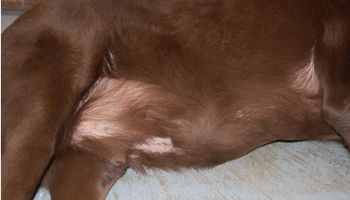
Pets with Cushings syndrome suffer from a chronic illness that will be managed throughout the pets life, not cured. This Team Meeting in a Box will help you deliver a successful team-wide approach. (Sponsored by Dechra)

Pets with Cushings syndrome suffer from a chronic illness that will be managed throughout the pets life, not cured. This Team Meeting in a Box will help you deliver a successful team-wide approach. (Sponsored by Dechra)

Is the feline diabetic patient every veterinarian's nightmare? Since diabetes mellitus is one of the most common endocrinopathies in cats, it is likely you will face this disease many times in your veterinary career.

When hyperthyroidism was first reported in cats as a disease entity approximately 25 years ago, the majority of cases were advanced. The cats were thin, aggressive, polyuric, polydipsic, polyphagic and had large palpable goiters.

Unfortunately, we don't really know how common clinically relevant pancreatitis really is in our feline patient population. Based on necropsy studies, pancreatic inflammation may be found in anywhere from <1% to 67% of cats, which is obviously an enormous range.

FLUTD refers to a spectrum of diseases that result in pollakiuria, hematuria, stranguria, dysuria and/or periuria in the cat. Common causes of these clinical signs include urolithiasis, urethral plugs and neoplasia (most commonly, transitional cell carcinoma).

Obesity is at epidemic proportions in the United States and worldwide. Despite major public health initiatives spanning several decades, human obesity has reached prevalence rates nearing 40% in some states.

Hypoadrenocorticism (Addison's disease ) is most common in dogs between 2-7 years of age. Breeds predilections include Standard Poodles, West Highland White Terriers, Rottweilers, Great Danes, Leonbergers, Nova Scotia Duck Tolling Retrievers, Portuguese Water Dogs, and Bearded Collies.

Anemia is a common blood work abnormality in many species, including cats. Determining the regenerative nature of the anemia guides the workup of the case. Regenerative anemias suggest blood loss or red cell lysis. Red cell lysis can be due to toxins, infectious agents, neoplasia (as a secondary immune-mediated phenomenon) or primary immune-mediated hemolytic anemia.

There are many different types of insulin that vary with species of origin and with chemical modifications and formulations that affect onset and duration of action. Porcine insulin, which is identical to canine insulin in its amino acid structure, is available for use in dogs in some countries, but, unfortunately, no specific feline insulin formulation is currently available.

These metabolic strategies mean that they are less efficient at "sopping up" post-prandial glucose loads that occur with high carbohydrate meals. Commercial dry diets, by virtue of the processing that must occur to create a dry diet, contain higher quantities of carbohydrates than the comparable canned diet.

Hyperaldosteronism is uncommon in dogs, but may be more common in cats than previously thought. Disorders of aldosterone deficiency have been recognized in combination with general adrenocortical insufficiency (Addison's disease), and will not be discussed here.

Recognizing hypertension in cats with hyperthyroidism is not always simple. In normal cats, measurement of blood pressure is fairly reliable, whether using oscillometry or Doppler ultrasonography.1 Both correlate well with intra-arterial measurements.2 The "white coat effect", however, is not always recognized in feline medicine, and this effect may well be more pronounced in cats with hyperthyroidism than in less stressed normal cats.

A recent retrospective study looked at factors that may influence survival in dogs with ADH medically managed with either trilostane or mitotane.

Gracie, a 10-year-old spayed cocker spaniel, was presented because she failed to regrow hair five months after surgery to remove a benign skin mass from the left lateral thorax.

In this interactive case, see if you can help Roscoe, a hunting dog experiencing intermittent vomiting.

Surgeon Dr. Jenifer Newton explains why this is no longer her treatment of choice.

The relationship between PTH concentrations and hypercalcemia.

Recent studies have shown a link between hypertriglyceridemia and conditions such as pancreatitis and hepatobiliary disease similar to what is seen in people.

This senior dog now also struggles to get up on the couch. Take a look at Jack's photo, assess his initial laboratory findings, and decide what test to do next.

Learn the signs and common treatments for the chronic and acute complications that may develop so you can help catch them early in your feline patients.

When trying to identify mild degrees of adrenocortical insufficiency or critical illness-related corticosteroid insufficiency, low-dose ACTH stimulation testing is necessary to achieve an accurate diagnosis. But what dose is best in cats?

Insulin has become increasingly important in the treatment of dogs and cats with diabetes mellitus. Almost all dogs are classified with insulin-dependent or type 1 diabetes mellitus.

The pancreas has both endocrine and exocrine functions. The endocrine pancreas consists of the islets of Langerhans and is particularly important to carbohydrate metabolism.

Diabetes mellitus (DM) is one of the two most common endocrine disorders in cats. While we tend to think of diabetes as a disease entity, we should remember that it really is a heterogeneous group of disorders in which insulin production is reduced or in which tissue cells are resistant to the effects of insulin, resulting in impaired glucose homeostasis.

For years, feline pancreatitis has been assumed to be a similar disease to that in dogs. As with so many other disorders, this group of disorders is different in the cat.